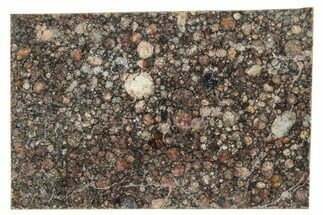This Specimen has been sold.
1.33" Cut Chondrite Meteorite Section (12.1 g) - NWA 869
This is a 1.33" wide (12.1 grams), cut section of a chondrite meteorite, NWA 869.
The NWA 869 Meteorite
This specimen is from one of the largest meteorite strewn fields ever discovered. The exact location is unknown since the finders have kept it a secret, but it is somewhere near the Morocco-Algeria border.
Scientifically, this chondrite contains very interesting materials: it is a breccia from the surface of its parent body and contains fragments of many different meteorite types. Enough variation is found in available material that NWA 869 could be sourced from multiple falls. It is primarily an L-type (ordinary) chondrite of differing petrographic grades, but some fragments of carbonaceous, achondritic, and other meteorite types are found in it as well.
Meteoritical Bulletin: Entry for NWA 869 Meteorite
This specimen is from one of the largest meteorite strewn fields ever discovered. The exact location is unknown since the finders have kept it a secret, but it is somewhere near the Morocco-Algeria border.
Scientifically, this chondrite contains very interesting materials: it is a breccia from the surface of its parent body and contains fragments of many different meteorite types. Enough variation is found in available material that NWA 869 could be sourced from multiple falls. It is primarily an L-type (ordinary) chondrite of differing petrographic grades, but some fragments of carbonaceous, achondritic, and other meteorite types are found in it as well.
Meteoritical Bulletin: Entry for NWA 869 Meteorite
About Chondrites
Chondrites are stony (non-metallic) meteorites that have not been modified by either melting or differentiation of the parent body. They are formed when various types of dust and small grains in the early Solar System accreted to form primitive asteroids. Some such bodies are captured in the planet’s gravity well and pulled to the surface. They are by far the most common type of meteorite, representing about 86 percent of all meteorites that have fallen to Earth.
Prominent among the components present in chondrites are the enigmatic chondrules, millimeter-sized spherical objects that originated as freely floating, molten or partially molten droplets in space; most chondrules are rich in the silicate minerals olivine and pyroxene. Chondrites also contain particles of various metals such as nickel, iron, and aluminum. These formed at the very beginning of the solar system and aggregated over time: they are the oldest rocks known on Earth!
Chondrites are divided into about fifteen distinct groups on the basis of their mineralogy, bulk chemical composition, and oxygen isotope compositions. The various chondrite groups likely originated on separate asteroids or groups of related asteroids. Each chondrite group has a distinctive mixture of chondrules, refractory inclusions, matrix (dust), characteristic chondrule sizes, and other components. Other ways of classifying chondrites include weathering and shock. The L chondrite group is the most common of these.
Chondrites are stony (non-metallic) meteorites that have not been modified by either melting or differentiation of the parent body. They are formed when various types of dust and small grains in the early Solar System accreted to form primitive asteroids. Some such bodies are captured in the planet’s gravity well and pulled to the surface. They are by far the most common type of meteorite, representing about 86 percent of all meteorites that have fallen to Earth.
Prominent among the components present in chondrites are the enigmatic chondrules, millimeter-sized spherical objects that originated as freely floating, molten or partially molten droplets in space; most chondrules are rich in the silicate minerals olivine and pyroxene. Chondrites also contain particles of various metals such as nickel, iron, and aluminum. These formed at the very beginning of the solar system and aggregated over time: they are the oldest rocks known on Earth!
Chondrites are divided into about fifteen distinct groups on the basis of their mineralogy, bulk chemical composition, and oxygen isotope compositions. The various chondrite groups likely originated on separate asteroids or groups of related asteroids. Each chondrite group has a distinctive mixture of chondrules, refractory inclusions, matrix (dust), characteristic chondrule sizes, and other components. Other ways of classifying chondrites include weathering and shock. The L chondrite group is the most common of these.
TYPE
Ordinary Chondrite (L4-6)
LOCATION
Morocco-Algeria Border
SIZE
1.33 x 1.04 x .47", 12.1 grams
CATEGORY
ITEM
#263196
 Reviews
Reviews












